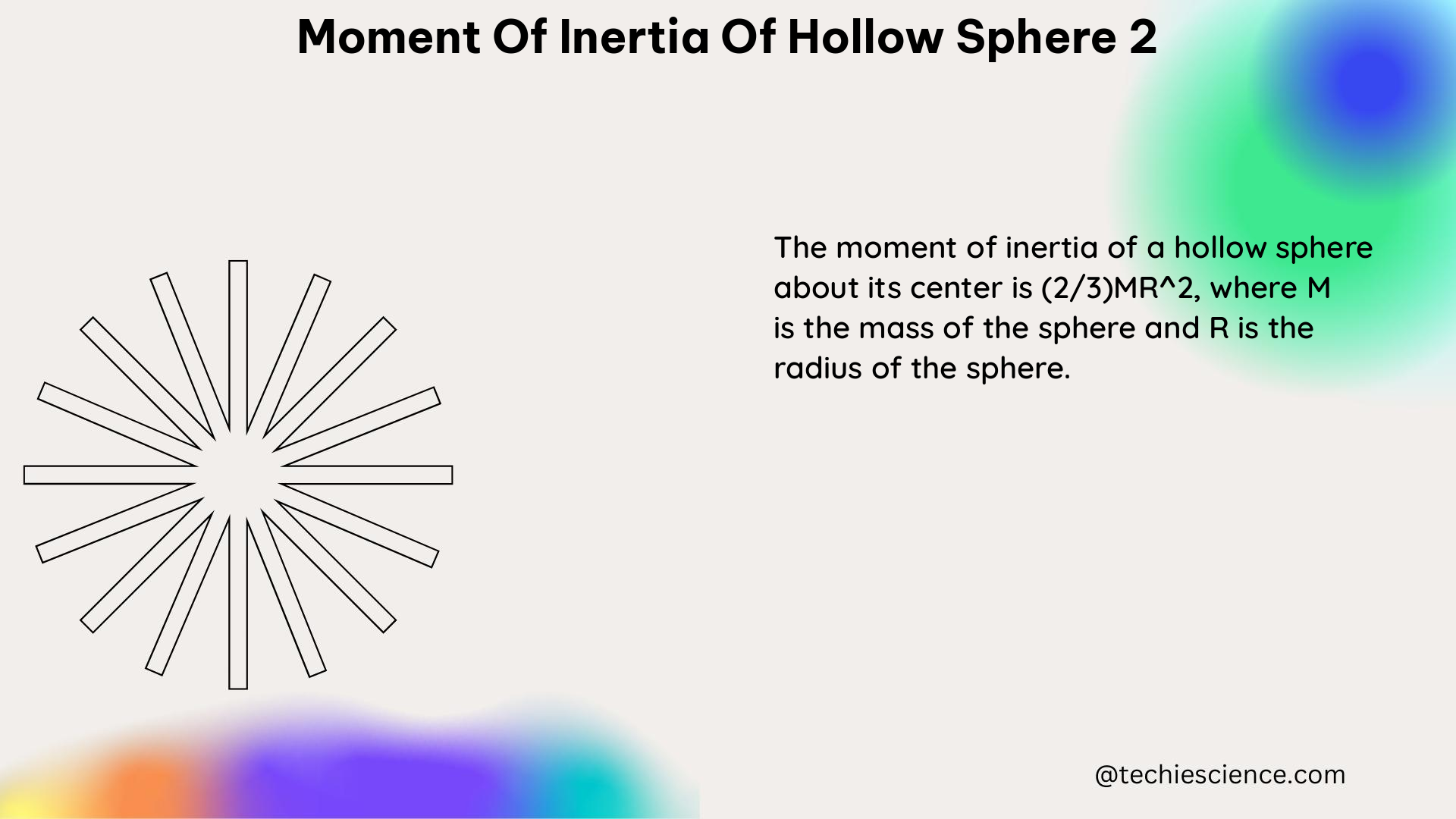The moment of inertia of a hollow sphere is a crucial concept in the study of rotational dynamics. It represents the resistance of a hollow sphere to changes in its rotational motion, and is a fundamental quantity in the analysis of various physical systems, from wheels and gears to flywheels and gyroscopes.
Understanding the Moment of Inertia Formula
The moment of inertia of a hollow sphere is given by the formula:
I = (2/3)MR^2
Where:
– I is the moment of inertia of the hollow sphere
– M is the mass of the hollow sphere
– R is the radius of the hollow sphere
This formula can be derived using calculus, as shown in various resources, such as the Byju’s article on the “Moment of Inertia Of A Hollow Sphere – Expression, Derivation And Problems.”
Comparing Hollow Sphere and Solid Sphere Moments of Inertia

It is important to note that the moment of inertia of a hollow sphere is greater than that of a solid sphere with the same mass and radius. This is because the mass of a hollow sphere is distributed further from the axis of rotation than the mass of a solid sphere.
The moment of inertia is proportional to the square of the distance of the mass from the axis of rotation. Therefore, a larger distance results in a larger moment of inertia. This is why a hollow sphere has a greater moment of inertia than a solid sphere.
Practical Applications of Hollow Sphere Moment of Inertia
The moment of inertia of a hollow sphere has numerous practical applications in various fields of physics and engineering. Some of the key applications include:
-
Rotational Dynamics: The moment of inertia is a crucial parameter in the analysis of rotational motion, such as the motion of wheels, gears, and flywheels.
-
Gyroscopes: Hollow spheres are often used in the construction of gyroscopes, where their moment of inertia plays a crucial role in the device’s stability and performance.
-
Mechanical Systems: The moment of inertia of a hollow sphere is an important consideration in the design and analysis of mechanical systems, such as those found in robotics, aerospace engineering, and automotive engineering.
-
Energy Storage: Hollow spheres can be used as flywheels for energy storage, where their moment of inertia determines the amount of energy that can be stored and released.
-
Pendulum Motion: The moment of inertia of a hollow sphere is a key factor in the analysis of pendulum motion, which has applications in timekeeping, seismology, and other fields.
Numerical Examples and Problems
To better understand the practical application of the moment of inertia formula for hollow spheres, let’s consider a few numerical examples and problems.
Example 1
Suppose we have a hollow sphere with a mass of 55.0 kg and a radius of 0.120 m. Calculate the moment of inertia of this hollow sphere.
Given:
– Mass (M) = 55.0 kg
– Radius (R) = 0.120 m
Substituting the values into the formula:
I = (2/3)MR^2
I = (2/3)(55.0 kg)(0.120 m)^2
I = 0.528 kg.m^2
Therefore, the moment of inertia of the hollow sphere is 0.528 kg.m^2.
Example 2
Compare the moment of inertia of a hollow sphere with that of a solid sphere, both having the same mass and radius.
Given:
– Mass (M) = 55.0 kg
– Radius (R) = 0.120 m
For a hollow sphere:
I_hollow = (2/3)MR^2
I_hollow = (2/3)(55.0 kg)(0.120 m)^2
I_hollow = 0.528 kg.m^2
For a solid sphere:
I_solid = (2/5)MR^2
I_solid = (2/5)(55.0 kg)(0.120 m)^2
I_solid = 0.396 kg.m^2
Comparing the two:
I_hollow = 0.528 kg.m^2
I_solid = 0.396 kg.m^2
The moment of inertia of the hollow sphere (0.528 kg.m^2) is greater than the moment of inertia of the solid sphere (0.396 kg.m^2) with the same mass and radius.
Problem 1
A hollow sphere has a mass of 10 kg and a radius of 0.5 m. Calculate the moment of inertia of the hollow sphere.
Problem 2
Compare the moment of inertia of a hollow sphere with a mass of 20 kg and a radius of 0.3 m to that of a solid sphere with the same mass and radius.
Problem 3
A hollow sphere is used as a flywheel in a mechanical system. The flywheel has a mass of 15 kg and a radius of 0.4 m. Calculate the amount of energy that can be stored in the flywheel, given that the maximum angular speed is 100 rad/s.
By working through these examples and problems, you can gain a deeper understanding of the moment of inertia of hollow spheres and its practical applications in various fields of physics and engineering.
Conclusion
The moment of inertia of a hollow sphere is a fundamental concept in the study of rotational dynamics. It represents the resistance of a hollow sphere to changes in its rotational motion and is a crucial quantity in the analysis of various physical systems. By understanding the moment of inertia formula, comparing it to solid spheres, and exploring its practical applications, you can develop a comprehensive understanding of this important topic in physics and engineering.
References
- Byju’s. (n.d.). Moment of Inertia Of A Hollow Sphere – Expression, Derivation And Problems. Retrieved from https://byjus.com/jee/moment-of-inertia-of-a-hollow-sphere/
- Physics Girl. (2020, April 1). Rotational Inertia – Hollow Sphere (part 1 of 2) [Video]. YouTube. Retrieved from https://www.youtube.com/watch?v=qhZ3oYuly_k
- Course Hero. (n.d.). Lab Exp 02.docx – Experiment Title: Determine the moment of inertia of solid cylinder and sphere. Retrieved from https://www.coursehero.com/file/69341358/Lab-Exp-02docx/

The lambdageeks.com Core SME Team is a group of experienced subject matter experts from diverse scientific and technical fields including Physics, Chemistry, Technology,Electronics & Electrical Engineering, Automotive, Mechanical Engineering. Our team collaborates to create high-quality, well-researched articles on a wide range of science and technology topics for the lambdageeks.com website.
All Our Senior SME are having more than 7 Years of experience in the respective fields . They are either Working Industry Professionals or assocaited With different Universities. Refer Our Authors Page to get to know About our Core SMEs.